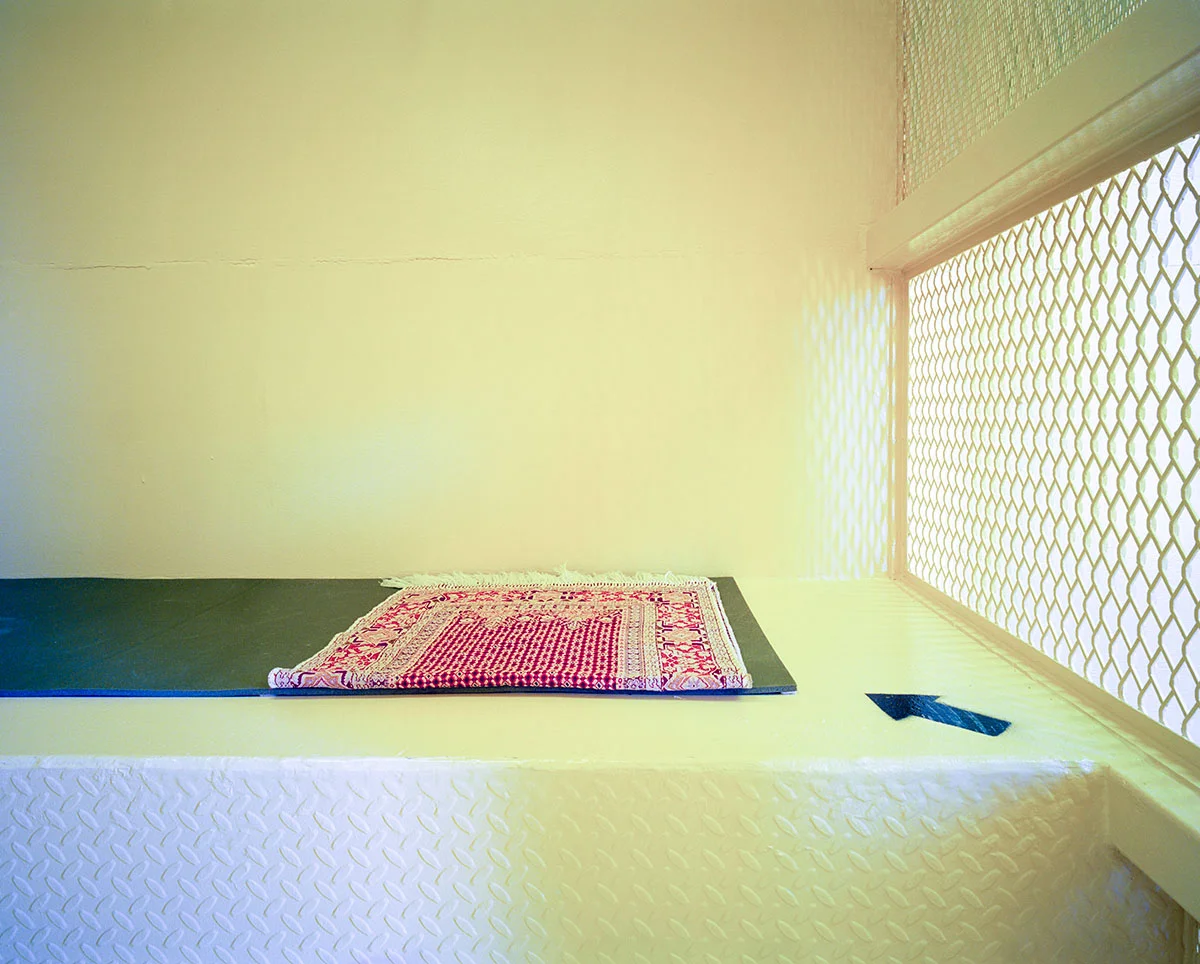Compliant Detainee © Debi Cornwall
Photographer Debi Cornwall's exhibition at Philadelphia Photo Arts unpacks the strange psychology and human experience of Guantanamo Bay through residential and leisure spaces and gift-shop souvenirs.
With the constant turmoil in the world today, one facet of American life that’s largely slipped from view is the United States government's continued imprisonment of people without access to legal counsel, the opportunity to defend themselves at trial, and have often tortured them for over a decade. President Obama pledged to close Guantanamo Bay during his first run, and ten years later, despite our stated withdrawal from Iraq, it still stands. It’s no longer at the level of moral outrage because we’ve allowed ourselves to ignore it. Just as we accept that Flint, Michigan, hasn’t had clean water for four years, we accept that America tortures and harms potentially innocent people in our name.
It was almost serendipitous – the day I went to see Debi Cornwall’s documentary photography show “Welcome to Camp America” at the Philadelphia Photo Arts Center, I’d just read an op-ed in the Los Angeles Times from Ahmed Rabbani, a detainee at Guantanamo Bay who has been held without trial for fourteen years.
Exhibition review by Deborah Krieger
Recreation Pen, Camp Echo U.S. Naval Station Guantánamo Bay, Cuba (2015)
© Debi Cornwall
“Welcome to Camp America” is Debi Cornwall’s masterful photo series of former detainees, all depicted from behind, alongside images of the camp itself. As if in a rebuke to the kind of thinking that turned Ahmed Rabbani into the number 1461, as he writes for the Los Angeles Times, Cornwall tells us the first names of the detainees in her pictures. The labels accompanying each photo give the subjects’ countries of origin, how long they were detained at Guantanamo, whether they were cleared or transferred to another institution, and tellingly, if charges were filed (notably, no charges were ever filed). Some detainees have been moved to another prison, while others have returned to their country of origin. Tellingly, the only staff member who is given their own photo is Terry, who served from 2003-4, converted to Islam, and was honorably discharged. No longer a part of the apparatus, he becomes individualized and gets his name back.
Taking in Cornwall’s images is like a crash course in seeing how facts can be whitewashed and obfuscated. It’s an exercise of being shocked and horrified, but not surprised. Because it’s never impacted me directly, I’ve never actually known what the American naval base at Guantanamo Bay looks like. I’ve pictured a sort of Shawshank-Redemption-looking building, its rattling gray stone and barred-up windows like teeth with braces—something that signals visually, cartoonishly, just how evil and sinister it is on the inside. As photographed by Cornwall, it’s actually an innocuous-looking campsite of buildings in neat rows, an endless array of ordinary-looking white rooms with small windows. Yet over the course of “Welcome to Camp America,” we see how somewhere so unspeakably awful appears so banal, even pleasant, and we see how the unlawful suffering of its detainees can even be commodified and sold.
Even using the term “detainee” instead of “prisoner” can function as a euphemistic legal workaround. Apparently, calling Guantanamo Bay a “prison” means that its occupants would have rights under the Geneva Convention. There’s the Orwellian-sounding “compliant detainees media room,” where a stuffed reclining chair sits behind a pair of manacles; there’s a “recreation pen” that’s just a large cage; there’s a room with a prayer rug and arrow pointing in the direction of Mecca. “It can’t be that bad,” we think—“look! They can pray!” They, not us—because it’s been made clear through over a decade of mass media that the people in Guantanamo Bay are “them” and not “us.”
Prayer Rug with Arrow to Mecca, Camp Echo U.S. Naval Station Guantánamo Bay, Cuba (2015)
© Debi Cornwall
Toddler Tee ($7.99)
© Debi Cornwall
It’s almost comical how callous the idea of Guantanamo Bay souvenirs is, yet, you can buy a bobblehead doll of Fidel Castro, or a shirt reading “I <3 Guantanamo Bay” in infant sizes, and there’s even a kiddie pool onsite. For the guards at Gitmo, there’s a kitschy nautical-themed galley; a driving range; and even a soundproofed band room. Cornwall captures this absurdity throughout her work. In one photograph, for example, three nameless guards stand in uniform, facing away from the viewer on their smoke break, staring out over the sparkling blue water. In another, a guard’s head is just barely visible over the back of a beach recliner, where he’s ostensibly enjoying a respite from his duties.
Smoke Break, Camp America U.S. Naval Station Guantánamo Bay, Cuba (2014)
© Debi Cornwall
On Windmill Beach U.S. Naval Station Guantánamo Bay, Cuba (2014) © Debi Cornwall
Kiddie Pool U.S. Naval Station Guantánamo Bay, Cuba (2015) © Debi Cornwall
As the accompanying exhibition essay notes, Cornwall isn’t giving us any kind of exposé on the hours of Gitmo – she was given strict directives of what she could and could not photograph, including no frontal, profile, or three-quarter views. Her photos had to be developed on-site and approved by the necessary authorities, who had veto power over every image she captured. Yet because she’s an artist, and because she’s so attuned to the visual, it’s the simplicity of Cornwall’s compositions that draw attention to the casual cruelties happening just out of sight, almost underplaying the horror in order to get the viewer to look and think: what’s wrong with this picture?








